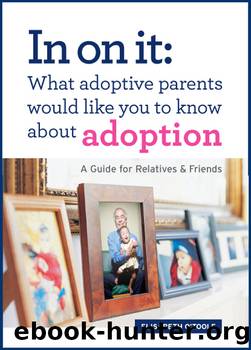In On It: What Adoptive Parents Would Like You To Know About Adoption by Elisabeth O'Toole

Author:Elisabeth O'Toole
Language: eng
Format: epub
ISBN: 978-1-934690-41-3
Publisher: Tasora Books
Published: 2010-01-15T00:00:00+00:00
Adopting older children
Adoptions of newborn infants are now the exception. Many adoptions involve older childrenâfrom several years old to teenagers. Adoptive parents of older children not only face unique issues in adoption but will likely face them immediately. As one mother of Russian-born girls adopted at ages one and four put it: âParenting an older adopted child is not the same as parenting a biological child or a child adopted as an infant. Period.â Following are some of the particular issues that parents adopting older children may have to addresss. Forming attachment. Building attachment and creating trust among immediate family members is paramount in adoptions of older children. Working to make the essential connections between parent and child (and siblings if theyâre involved) is a deliberate process; the adoptive parents usually wonât just rely on time and affection to draw the family together. Rather, they will pursue specific, conscientious strategies to do so. Consider that an older child will often have had several caregivers (versus a single primary caregiver) prior to his adoptive parents. The child may no longer trust that connections will last; he may have learned to always be looking for his next caregiver. It is essential that the child begin identifying his adoptive parents as his primary and permanent caregivers.
To achieve this, your loved ones may do things like require that they be the only people to provide direct care to the child. They may ask, for example, that no one but a parent feed or diaper the child. One adoptive mother described asking her mother repeatedly not to feed her child directly, telling her âa potato chip is not always just a potato chip.â A further complication occurred when the grandmother then challenged the mother about this approach in front of the child. The grandmother may have been used to a conversation style that involved casually (and publicly) arguing with her daughter over minor issues. But now the adoptive mother needed her newly-arrived child to see herâthe childâs new motherâas having final authority in the home. Understand that actions or words that might otherwise seem innocuous or unremarkable can cause unintended harm when they involve a new adoptive family immersed in the critical process of securing attachment.
Securing attachment with a child who has experienced abandonment or trauma or who has had little constancy in their past can be complicated. Itâs important that the people around the new family understand that this is critical work for the family. Some families âcocoonâ for months, getting to know each other and building the base for their lifelong parent-child connection before they begin expanding the childâs circle of visitors and caregivers. Often, other relationships must come second to this process.
Friends and family may find these boundaries confusing or unreasonable. After all, you, too, have been waiting for the child and are eager to begin knowing him. If parents set up systems or limits that donât make sense to you or with which you donât agree, ask them to help you understand them.
Download
This site does not store any files on its server. We only index and link to content provided by other sites. Please contact the content providers to delete copyright contents if any and email us, we'll remove relevant links or contents immediately.
The Incest Diary by Anonymous(7526)
The Lost Art of Listening by Michael P. Nichols(7373)
The Rosie Project by Graeme Simsion(6139)
Beartown by Fredrik Backman(5563)
We Need to Talk by Celeste Headlee(5515)
Ego Is the Enemy by Ryan Holiday(5251)
Hunger by Roxane Gay(4846)
Suicide Notes by Michael Thomas Ford(4710)
I Love You But I Don't Trust You by Mira Kirshenbaum(3787)
Mummy Knew by Lisa James(3593)
Not a Diet Book by James Smith(3309)
Crazy Is My Superpower by A.J. Mendez Brooks(3285)
Girl, Wash Your Face by Rachel Hollis(3183)
Toxic Parents by Susan Forward(3178)
The Complete Idiot's Guide to Coping With Difficult People by Arlene Uhl(3103)
Name Book, The: Over 10,000 Names--Their Meanings, Origins, and Spiritual Significance by Astoria Dorothy(2918)
The Social Psychology of Inequality by Unknown(2914)
The Hard Questions by Susan Piver(2876)
The Gaslight Effect by Dr. Robin Stern(2716)
